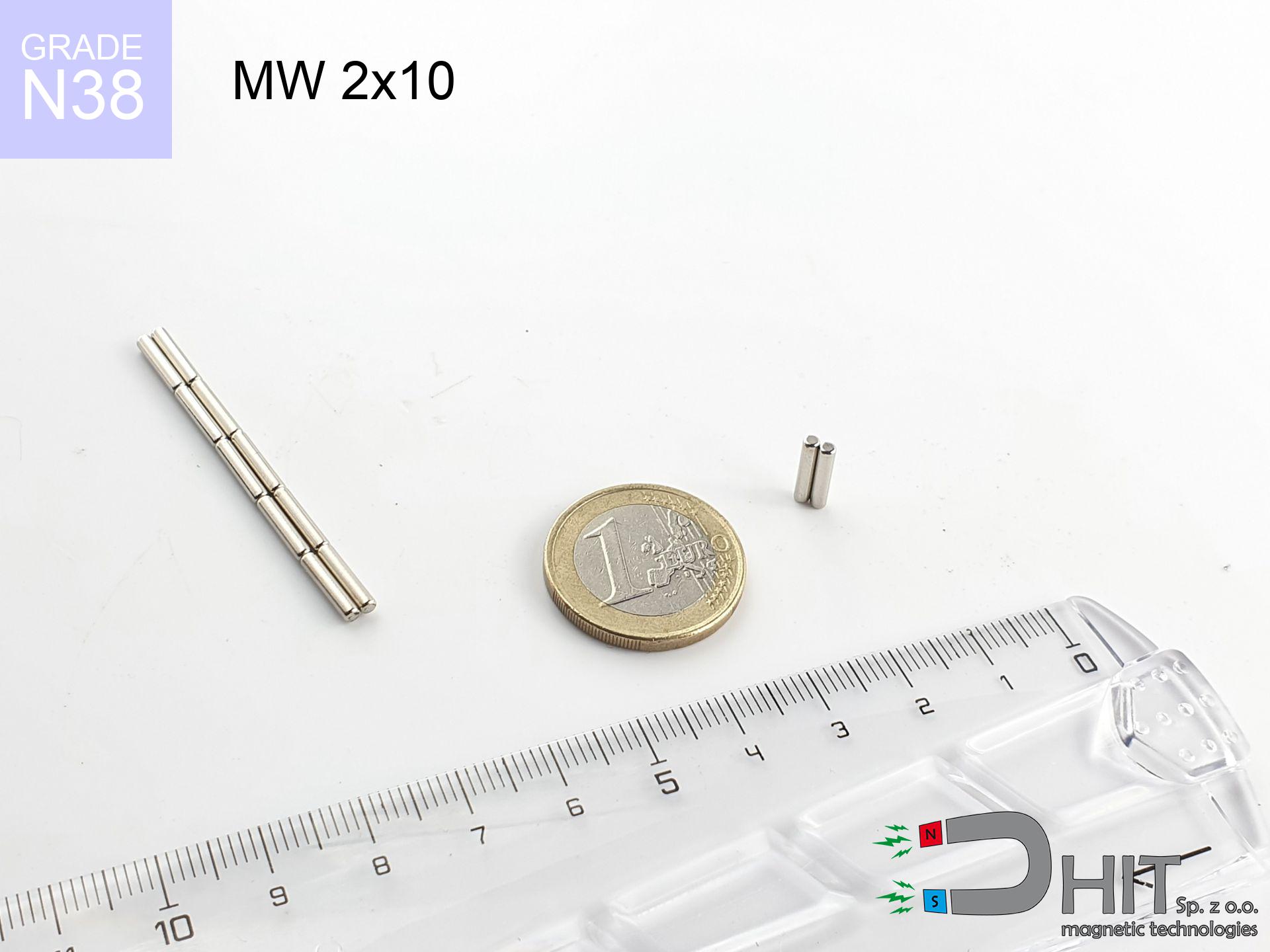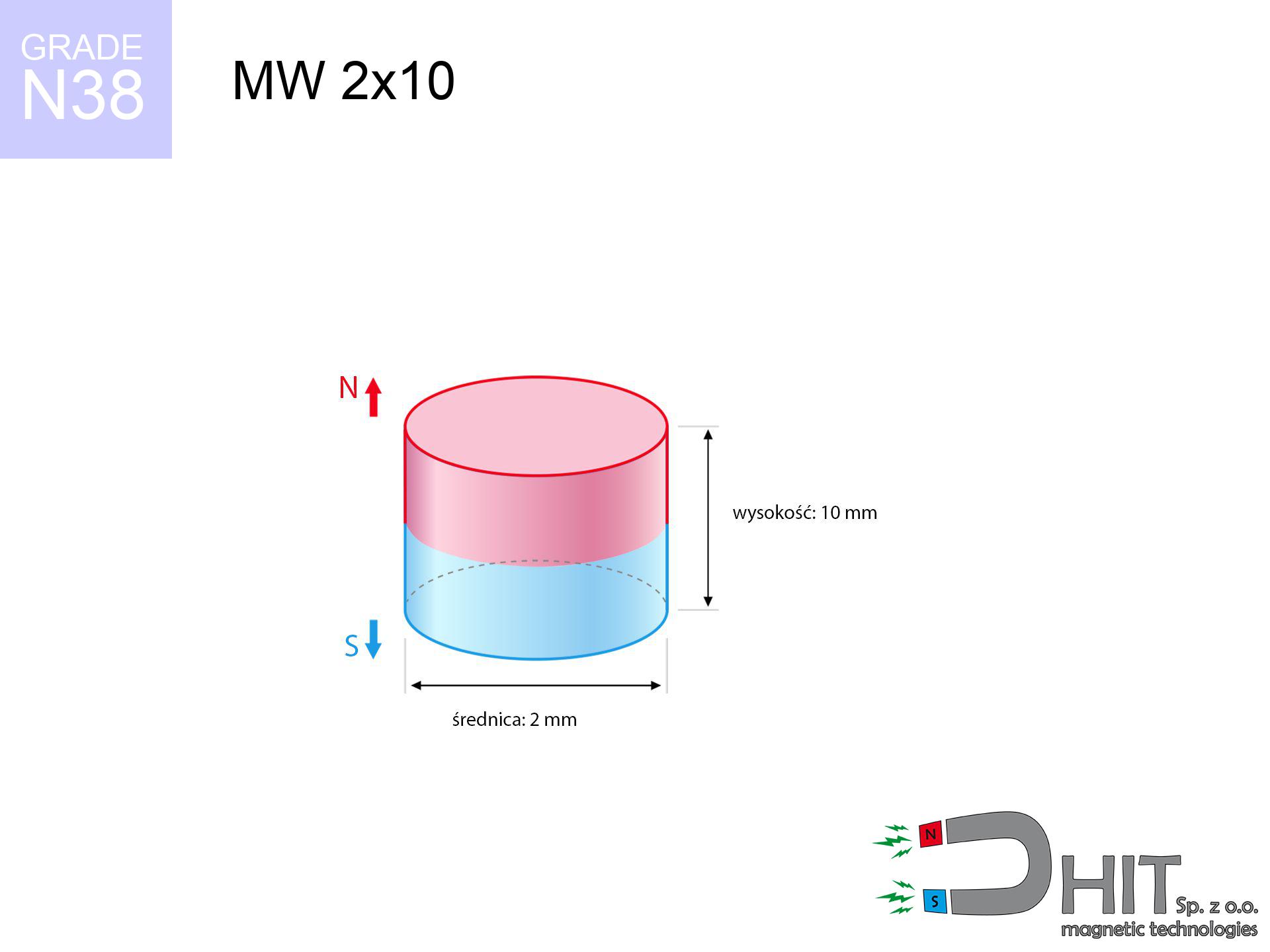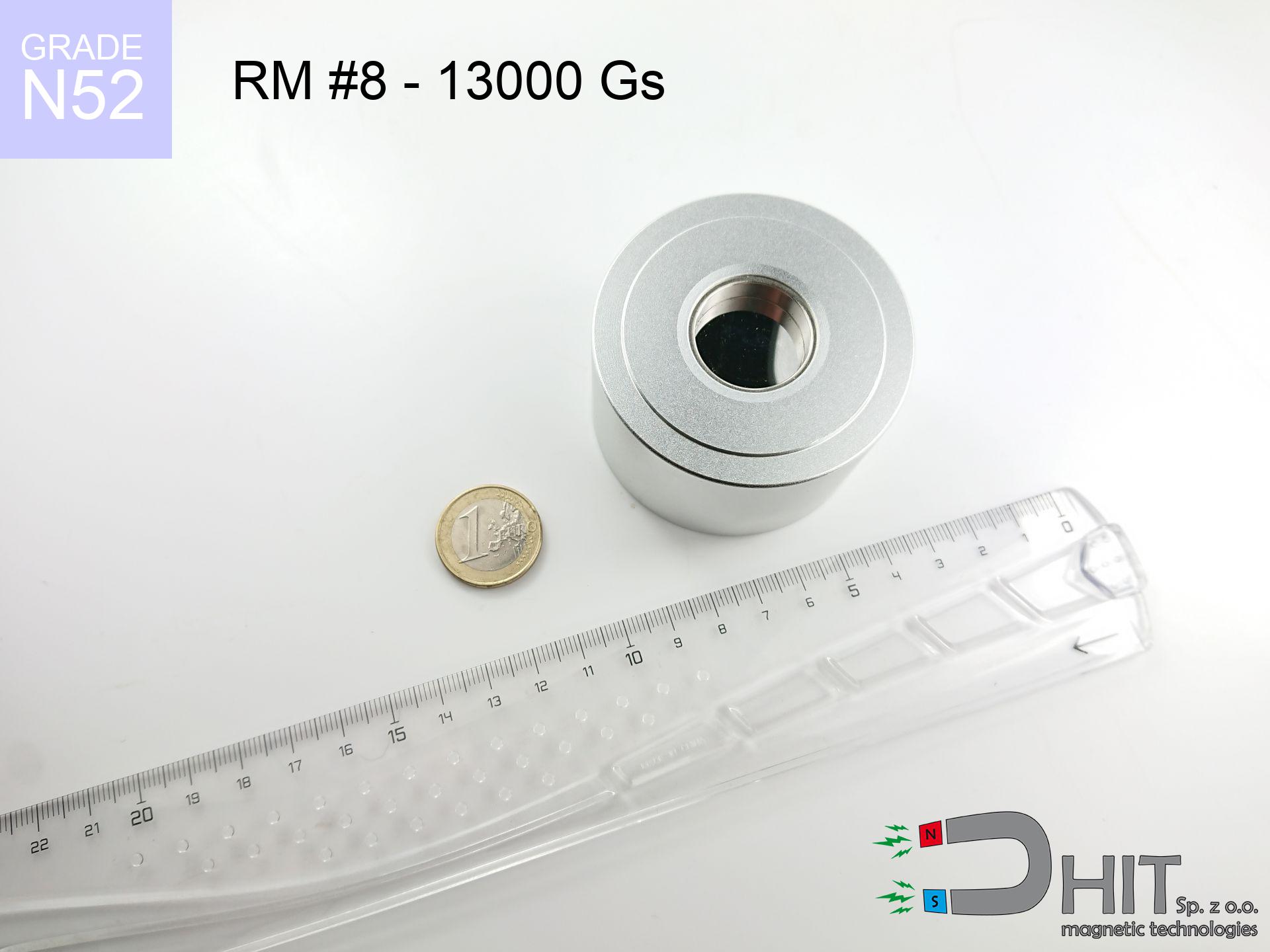MW 2x10 / N38 - cylindrical magnet
cylindrical magnet
Catalog no 010054
GTIN/EAN: 5906301810537
Diameter Ø
2 mm [±0,1 mm]
Height
10 mm [±0,1 mm]
Weight
0.24 g
Magnetization Direction
↑ axial
Load capacity
0.07 kg / 0.70 N
Magnetic Induction
613.08 mT / 6131 Gs
Coating
[NiCuNi] Nickel
0.1845 ZŁ with VAT / pcs + price for transport
0.1500 ZŁ net + 23% VAT / pcs
bulk discounts:
Need more?Do you have questions?
Give us a call
+48 22 499 98 98
alternatively let us know via
inquiry form
the contact page.
Parameters along with form of a neodymium magnet can be checked using our
modular calculator.
Same-day processing for orders placed before 14:00.
MW 2x10 / N38 - cylindrical magnet
Specification / characteristics MW 2x10 / N38 - cylindrical magnet
| properties | values |
|---|---|
| Cat. no. | 010054 |
| GTIN/EAN | 5906301810537 |
| Production/Distribution | Dhit sp. z o.o. |
| Country of origin | Poland / China / Germany |
| Customs code | 85059029 |
| Diameter Ø | 2 mm [±0,1 mm] |
| Height | 10 mm [±0,1 mm] |
| Weight | 0.24 g |
| Magnetization Direction | ↑ axial |
| Load capacity ~ ? | 0.07 kg / 0.70 N |
| Magnetic Induction ~ ? | 613.08 mT / 6131 Gs |
| Coating | [NiCuNi] Nickel |
| Manufacturing Tolerance | ±0.1 mm |
Magnetic properties of material N38
| properties | values | units |
|---|---|---|
| remenance Br [min. - max.] ? | 12.2-12.6 | kGs |
| remenance Br [min. - max.] ? | 1220-1260 | mT |
| coercivity bHc ? | 10.8-11.5 | kOe |
| coercivity bHc ? | 860-915 | kA/m |
| actual internal force iHc | ≥ 12 | kOe |
| actual internal force iHc | ≥ 955 | kA/m |
| energy density [min. - max.] ? | 36-38 | BH max MGOe |
| energy density [min. - max.] ? | 287-303 | BH max KJ/m |
| max. temperature ? | ≤ 80 | °C |
Physical properties of sintered neodymium magnets Nd2Fe14B at 20°C
| properties | values | units |
|---|---|---|
| Vickers hardness | ≥550 | Hv |
| Density | ≥7.4 | g/cm3 |
| Curie Temperature TC | 312 - 380 | °C |
| Curie Temperature TF | 593 - 716 | °F |
| Specific resistance | 150 | μΩ⋅cm |
| Bending strength | 250 | MPa |
| Compressive strength | 1000~1100 | MPa |
| Thermal expansion parallel (∥) to orientation (M) | (3-4) x 10-6 | °C-1 |
| Thermal expansion perpendicular (⊥) to orientation (M) | -(1-3) x 10-6 | °C-1 |
| Young's modulus | 1.7 x 104 | kg/mm² |
Technical analysis of the magnet - report
The following values are the direct effect of a mathematical calculation. Values rely on algorithms for the material Nd2Fe14B. Operational parameters might slightly differ from theoretical values. Please consider these calculations as a preliminary roadmap for designers.
MW 2x10 / N38
| Distance (mm) | Induction (Gauss) / mT | Pull Force (kg) | Risk Status |
|---|---|---|---|
| 0 mm |
6107 Gs
610.7 mT
|
0.07 kg / 70.0 g
0.7 N
|
low risk |
| 1 mm |
1790 Gs
179.0 mT
|
0.01 kg / 6.0 g
0.1 N
|
low risk |
| 2 mm |
633 Gs
63.3 mT
|
0.00 kg / 0.8 g
0.0 N
|
low risk |
| 3 mm |
300 Gs
30.0 mT
|
0.00 kg / 0.2 g
0.0 N
|
low risk |
| 5 mm |
107 Gs
10.7 mT
|
0.00 kg / 0.0 g
0.0 N
|
low risk |
| 10 mm |
23 Gs
2.3 mT
|
0.00 kg / 0.0 g
0.0 N
|
low risk |
| 15 mm |
9 Gs
0.9 mT
|
0.00 kg / 0.0 g
0.0 N
|
low risk |
| 20 mm |
4 Gs
0.4 mT
|
0.00 kg / 0.0 g
0.0 N
|
low risk |
| 30 mm |
2 Gs
0.2 mT
|
0.00 kg / 0.0 g
0.0 N
|
low risk |
| 50 mm |
0 Gs
0.0 mT
|
0.00 kg / 0.0 g
0.0 N
|
low risk |
MW 2x10 / N38
| Distance (mm) | Friction coefficient | Pull Force (kg) |
|---|---|---|
| 0 mm | Stal (~0.2) |
0.01 kg / 14.0 g
0.1 N
|
| 1 mm | Stal (~0.2) |
0.00 kg / 2.0 g
0.0 N
|
| 2 mm | Stal (~0.2) |
0.00 kg / 0.0 g
0.0 N
|
| 3 mm | Stal (~0.2) |
0.00 kg / 0.0 g
0.0 N
|
| 5 mm | Stal (~0.2) |
0.00 kg / 0.0 g
0.0 N
|
| 10 mm | Stal (~0.2) |
0.00 kg / 0.0 g
0.0 N
|
| 15 mm | Stal (~0.2) |
0.00 kg / 0.0 g
0.0 N
|
| 20 mm | Stal (~0.2) |
0.00 kg / 0.0 g
0.0 N
|
| 30 mm | Stal (~0.2) |
0.00 kg / 0.0 g
0.0 N
|
| 50 mm | Stal (~0.2) |
0.00 kg / 0.0 g
0.0 N
|
MW 2x10 / N38
| Surface type | Friction coefficient / % Mocy | Max load (kg) |
|---|---|---|
| Raw steel |
µ = 0.3
30% Nominalnej Siły
|
0.02 kg / 21.0 g
0.2 N
|
| Painted steel (standard) |
µ = 0.2
20% Nominalnej Siły
|
0.01 kg / 14.0 g
0.1 N
|
| Oily/slippery steel |
µ = 0.1
10% Nominalnej Siły
|
0.01 kg / 7.0 g
0.1 N
|
| Magnet with anti-slip rubber |
µ = 0.5
50% Nominalnej Siły
|
0.04 kg / 35.0 g
0.3 N
|
MW 2x10 / N38
| Steel thickness (mm) | % power | Real pull force (kg) |
|---|---|---|
| 0.5 mm |
|
0.01 kg / 7.0 g
0.1 N
|
| 1 mm |
|
0.02 kg / 17.5 g
0.2 N
|
| 2 mm |
|
0.04 kg / 35.0 g
0.3 N
|
| 5 mm |
|
0.07 kg / 70.0 g
0.7 N
|
| 10 mm |
|
0.07 kg / 70.0 g
0.7 N
|
MW 2x10 / N38
| Ambient temp. (°C) | Power loss | Remaining pull | Status |
|---|---|---|---|
| 20 °C | 0.0% |
0.07 kg / 70.0 g
0.7 N
|
OK |
| 40 °C | -2.2% |
0.07 kg / 68.5 g
0.7 N
|
OK |
| 60 °C | -4.4% |
0.07 kg / 66.9 g
0.7 N
|
OK |
| 80 °C | -6.6% |
0.07 kg / 65.4 g
0.6 N
|
|
| 100 °C | -28.8% |
0.05 kg / 49.8 g
0.5 N
|
MW 2x10 / N38
| Gap (mm) | Attraction (kg) (N-S) | Repulsion (kg) (N-N) |
|---|---|---|
| 0 mm |
0.72 kg / 722 g
7.1 N
6 130 Gs
|
N/A |
| 1 mm |
0.22 kg / 224 g
2.2 N
6 799 Gs
|
0.20 kg / 201 g
2.0 N
~0 Gs
|
| 2 mm |
0.06 kg / 62 g
0.6 N
3 581 Gs
|
0.06 kg / 56 g
0.5 N
~0 Gs
|
| 3 mm |
0.02 kg / 20 g
0.2 N
2 036 Gs
|
0.02 kg / 18 g
0.2 N
~0 Gs
|
| 5 mm |
0.00 kg / 3 g
0.0 N
847 Gs
|
0.00 kg / 0 g
0.0 N
~0 Gs
|
| 10 mm |
0.00 kg / 0 g
0.0 N
213 Gs
|
0.00 kg / 0 g
0.0 N
~0 Gs
|
| 20 mm |
0.00 kg / 0 g
0.0 N
46 Gs
|
0.00 kg / 0 g
0.0 N
~0 Gs
|
| 50 mm |
0.00 kg / 0 g
0.0 N
5 Gs
|
0.00 kg / 0 g
0.0 N
~0 Gs
|
MW 2x10 / N38
| Object / Device | Limit (Gauss) / mT | Safe distance |
|---|---|---|
| Pacemaker | 5 Gs (0.5 mT) | 2.0 cm |
| Hearing aid | 10 Gs (1.0 mT) | 1.5 cm |
| Mechanical watch | 20 Gs (2.0 mT) | 1.5 cm |
| Phone / Smartphone | 40 Gs (4.0 mT) | 1.0 cm |
| Car key | 50 Gs (5.0 mT) | 1.0 cm |
| Payment card | 400 Gs (40.0 mT) | 0.5 cm |
| HDD hard drive | 600 Gs (60.0 mT) | 0.5 cm |
MW 2x10 / N38
| Start from (mm) | Speed (km/h) | Energy (J) | Predicted outcome |
|---|---|---|---|
| 10 mm |
17.22 km/h
(4.78 m/s)
|
0.00 J | |
| 30 mm |
29.83 km/h
(8.29 m/s)
|
0.01 J | |
| 50 mm |
38.51 km/h
(10.70 m/s)
|
0.01 J | |
| 100 mm |
54.47 km/h
(15.13 m/s)
|
0.03 J |
MW 2x10 / N38
| Technical parameter | Value / Description |
|---|---|
| Coating type | [NiCuNi] Nickel |
| Layer structure | Nickel - Copper - Nickel |
| Layer thickness | 10-20 µm |
| Salt spray test (SST) ? | 24 h |
| Recommended environment | Indoors only (dry) |
MW 2x10 / N38
| Parameter | Value | SI Unit / Description |
|---|---|---|
| Magnetic Flux | 232 Mx | 2.3 µWb |
| Pc Coefficient | 1.55 | High (Stable) |
MW 2x10 / N38
| Environment | Effective steel pull | Effect |
|---|---|---|
| Air (land) | 0.07 kg | Standard |
| Water (riverbed) |
0.08 kg
(+0.01 kg Buoyancy gain)
|
+14.5% |
1. Sliding resistance
*Caution: On a vertical surface, the magnet retains merely a fraction of its nominal pull.
2. Efficiency vs thickness
*Thin metal sheet (e.g. computer case) drastically limits the holding force.
3. Thermal stability
*For N38 material, the max working temp is 80°C.
4. Demagnetization curve and operating point (B-H)
chart generated for the permeance coefficient Pc (Permeance Coefficient) = 1.55
This simulation demonstrates the magnetic stability of the selected magnet under specific geometric conditions. The solid red line represents the demagnetization curve (material potential), while the dashed blue line is the load line based on the magnet's geometry. The Pc (Permeance Coefficient), also known as the load line slope, is a dimensionless value that describes the relationship between the magnet's shape and its magnetic stability. The intersection of these two lines (the black dot) is the operating point — it determines the actual magnetic flux density generated by the magnet in this specific configuration. A higher Pc value means the magnet is more 'slender' (tall relative to its area), resulting in a higher operating point and better resistance to irreversible demagnetization caused by external fields or temperature. A value of 0.42 is relatively low (typical for flat magnets), meaning the operating point is closer to the 'knee' of the curve — caution is advised when operating at temperatures near the maximum limit to avoid strength loss.
Material specification
| iron (Fe) | 64% – 68% |
| neodymium (Nd) | 29% – 32% |
| boron (B) | 1.1% – 1.2% |
| dysprosium (Dy) | 0.5% – 2.0% |
| coating (Ni-Cu-Ni) | < 0.05% |
Environmental data
| recyclability (EoL) | 100% |
| recycled raw materials | ~10% (pre-cons) |
| carbon footprint | low / zredukowany |
| waste code (EWC) | 16 02 16 |
Other offers
Strengths as well as weaknesses of rare earth magnets.
Advantages
- Their strength is durable, and after approximately 10 years it decreases only by ~1% (theoretically),
- They are extremely resistant to demagnetization induced by external field influence,
- The use of an metallic finish of noble metals (nickel, gold, silver) causes the element to present itself better,
- Magnetic induction on the top side of the magnet remains impressive,
- Thanks to resistance to high temperature, they are able to function (depending on the shape) even at temperatures up to 230°C and higher...
- Thanks to flexibility in forming and the ability to adapt to complex applications,
- Significant place in modern industrial fields – they are commonly used in computer drives, motor assemblies, precision medical tools, also technologically advanced constructions.
- Relatively small size with high pulling force – neodymium magnets offer impressive pulling force in tiny dimensions, which makes them useful in small systems
Disadvantages
- To avoid cracks upon strong impacts, we recommend using special steel housings. Such a solution secures the magnet and simultaneously improves its durability.
- NdFeB magnets demagnetize when exposed to high temperatures. After reaching 80°C, many of them experience permanent weakening of power (a factor is the shape and dimensions of the magnet). We offer magnets specially adapted to work at temperatures up to 230°C marked [AH], which are very resistant to heat
- When exposed to humidity, magnets start to rust. For applications outside, it is recommended to use protective magnets, such as those in rubber or plastics, which prevent oxidation and corrosion.
- Limited possibility of creating nuts in the magnet and complicated shapes - recommended is a housing - mounting mechanism.
- Health risk to health – tiny shards of magnets are risky, if swallowed, which becomes key in the context of child health protection. It is also worth noting that tiny parts of these devices can complicate diagnosis medical in case of swallowing.
- Due to neodymium price, their price is relatively high,
Pull force analysis
Maximum holding power of the magnet – what contributes to it?
- on a block made of mild steel, optimally conducting the magnetic flux
- possessing a thickness of at least 10 mm to ensure full flux closure
- with a surface free of scratches
- under conditions of gap-free contact (metal-to-metal)
- during detachment in a direction vertical to the plane
- at conditions approx. 20°C
Determinants of practical lifting force of a magnet
- Air gap (between the magnet and the metal), because even a tiny clearance (e.g. 0.5 mm) leads to a reduction in lifting capacity by up to 50% (this also applies to paint, corrosion or dirt).
- Loading method – catalog parameter refers to pulling vertically. When slipping, the magnet holds much less (often approx. 20-30% of nominal force).
- Metal thickness – the thinner the sheet, the weaker the hold. Magnetic flux penetrates through instead of converting into lifting capacity.
- Material type – the best choice is high-permeability steel. Hardened steels may have worse magnetic properties.
- Surface finish – full contact is possible only on polished steel. Rough texture reduce the real contact area, reducing force.
- Temperature influence – hot environment reduces pulling force. Too high temperature can permanently demagnetize the magnet.
Lifting capacity testing was carried out on plates with a smooth surface of optimal thickness, under perpendicular forces, in contrast under attempts to slide the magnet the load capacity is reduced by as much as fivefold. In addition, even a slight gap between the magnet’s surface and the plate decreases the lifting capacity.
Implant safety
People with a ICD have to keep an absolute distance from magnets. The magnetic field can disrupt the functioning of the implant.
Physical harm
Protect your hands. Two powerful magnets will snap together instantly with a force of massive weight, crushing everything in their path. Exercise extreme caution!
Do not give to children
These products are not suitable for play. Swallowing multiple magnets can lead to them pinching intestinal walls, which poses a severe health hazard and necessitates immediate surgery.
Mechanical processing
Drilling and cutting of neodymium magnets poses a fire risk. Magnetic powder reacts violently with oxygen and is difficult to extinguish.
Material brittleness
Beware of splinters. Magnets can fracture upon violent connection, ejecting sharp fragments into the air. Eye protection is mandatory.
GPS Danger
Be aware: rare earth magnets generate a field that confuses sensitive sensors. Keep a separation from your mobile, device, and navigation systems.
Data carriers
Avoid bringing magnets close to a purse, laptop, or screen. The magnetism can irreversibly ruin these devices and erase data from cards.
Handling rules
Exercise caution. Neodymium magnets act from a distance and snap with massive power, often quicker than you can move away.
Warning for allergy sufferers
Allergy Notice: The Ni-Cu-Ni coating contains nickel. If skin irritation occurs, immediately stop handling magnets and wear gloves.
Do not overheat magnets
Watch the temperature. Heating the magnet above 80 degrees Celsius will permanently weaken its magnetic structure and strength.





![HH 16x5.3 [M3] / N38 - through hole magnetic holder HH 16x5.3 [M3] / N38 - through hole magnetic holder](https://cdn3.dhit.pl/graphics/products/hh-16x5.3-m3-sud.jpg)



